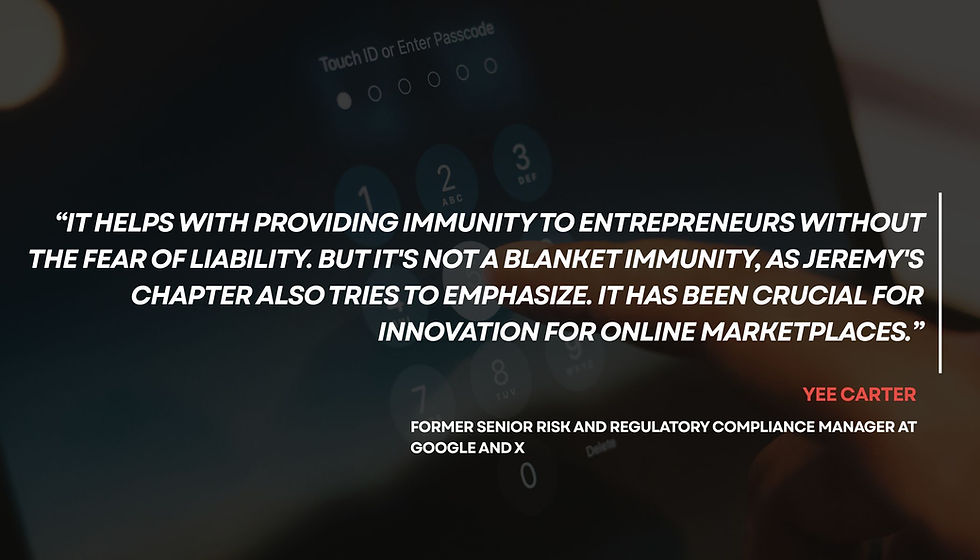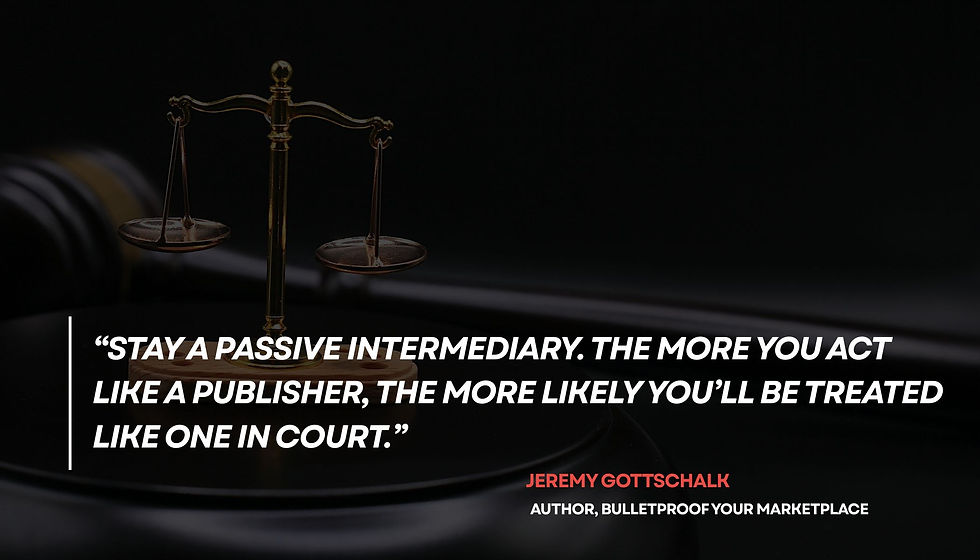How Section 230 Protects Your Platform
- Aug 7
- 4 min read
Updated: Aug 11
From “How Section 230 Protects Your Platform,” Chapter 2 of Bulletproof Your Marketplace by Jeremy Gottschalk, featuring insights from the Marketplace Risk Platforms Podcast conversation with Yee Carter, former Senior Risk and Regulatory Compliance Manager at Google and X.
If you operate a digital platform or marketplace in the United States, there’s one law you need to understand inside and out: Section 230 of the Communications Decency Act (CDA). It’s arguably the single most important legal protection for the internet economy — and, as risk and compliance expert Yee Carter notes, it’s “been crucial for innovation” in the marketplace ecosystem.
“Amazon, Etsy might not have existed without Section 230 because of lawsuits and user misconduct,” Carter explains in our recent Bulletproof Your Marketplace podcast episode (listen here). “It gives broad immunity to online marketplaces — but it’s not a blanket immunity.”
What Section 230 Actually Does
Section 230 shields “interactive computer services” — which includes most online platforms — from being treated as the publisher or speaker of content created by their users.
Put simply: if two users have a dispute, someone posts offensive content, or there’s a misunderstanding over a service, you as the platform are not legally on the hook for that because it is purely the result of user-generated content.
This safe harbor is what allowed early marketplaces to flourish without being sued out of existence. Without it, platforms like eBay, Etsy, Uber, Airbnb, and even Facebook, might never have scaled.

Why This Law Changed the Game
Back in the 1990s, the internet was the Wild West. Courts were split — some treated platforms like bookstores (not responsible for the content on the shelves), others treated them like newspapers (liable for what is printed). This created confusion, fear, and a legal minefield for platforms trying to scale.
Congress stepped in and passed the Communication Decency Act (and as a part of that Act, Section 230) in 1996 to fix this problem. Without it, platforms like eBay, Etsy, Uber, Airbnb, and Facebook probably wouldn’t exist today. Section 230 created a safe harbor that let entrepreneurs build marketplaces without being sued every time something went wrong between users.
As Jeremy puts it:
“Section 230 didn’t just save the internet—it launched it.”
Real-World Protection, Real-Life Cases
Jeremy highlights landmark court cases that shaped Section 230’s protections:
Zeran v. AOL: AOL was protected after someone maliciously posted false ads that led to harassment. The court ruled AOL wasn’t the publisher.
Gentry v. eBay: A user sued eBay over fake sports memorabilia, but the court said eBay wasn’t responsible for third-party seller content.
Doe v. MySpace: Even when a user misrepresented their age and harm occurred offline, MySpace was shielded because it didn’t create the content or facilitate the meeting.
These aren’t edge cases — they’re the legal backbone of our entire industry.
Carter adds perspective on the blurred lines of platform liability with this example:
“In 2017, and again in 2024, Amazon faced backlash over solar eclipse glasses sold on its marketplace. They were marketed as ISO-compliant but lacked proper certification. The key question became: was Amazon just the platform — or also the seller?”
While Amazon wasn’t held liable under Section 230, this incident pushed them to expand risk and compliance teams and tighten seller verification — a lesson for any marketplace on proactive risk management.
But Here’s the Catch: Section 230 Is Not Unlimited
Many founders think Section 230 is a get-out-of-jail-free card. It’s not. Platforms can lose protection if:
They create or manipulate content. For example, writing posts themselves, designing discriminatory dropdown menus, or using AI to auto-generate risky language means the platform owns that content.
They make promises they don’t keep. If you claim your platform verifies identities, checks backgrounds, or guarantees safety—but something goes wrong—that’s on you.
They ignore federal laws or intellectual property violations. Section 230 doesn’t protect against federal crimes, trafficking, or IP infringement.
They operate outside U.S. jurisdiction. Section 230 is a U.S. law; other countries have different rules.

The Next Frontier: AI, Algorithms, and New Legal Risks
One of the most pressing questions today is how AI and algorithmic recommendations fit into Section 230’s framework.
Carter points to a recent case:
“TikTok’s Anderson case shows that recommendations could be considered platform-generated content if they actively promote harmful material. As AI and chatbots become more integrated, we’re going to see lawsuits testing whether those outputs are protected under Section 230.”
Jeremy adds nuance:
“Even if a platform loses Section 230 protection, it doesn’t mean automatic liability. But without early dismissal, legal fees can skyrocket into the millions.”
The rise of AI-generated content — from chatbots to recommendation engines — presents new risks that marketplace leaders must carefully evaluate.
Political Pressure and Potential Change
Section 230 is “at a tipping point,” Carter warns, due to growing bipartisan political interest in reform.
“There’s widespread consensus it will likely change — the question is when.”
Platforms today face mounting pressure to moderate content more aggressively while navigating complex legal and political expectations.
Carter observes:
“There’s a lot of confusion about what platforms stand for and what will be enforced, which complicates risk management and policy decisions.”
Marketplace leaders should monitor these developments closely, audit their policies, and prepare to adapt to a post-230 world.
Why This Matters More Than Ever
Section 230 remains the cornerstone legal shield for digital platforms in the U.S. But as Carter reminds us:
“It’s been pivotal — but it’s not forever. Innovation will need to evolve alongside the law.”
Jeremy’s advice to every platform:
“Build around Section 230. Are you acting as a passive intermediary? Are you avoiding creating or editing user content? Are you making promises you can actually keep? If you’re unsure, take a hard look at your policies, terms, and features.”
Bulletproof Your Marketplace calls this chapter a wake-up call: treat Section 230 with the respect it deserves, because it’s your best legal friend — for now.
Want more tools to legally protect your platform?
Visit www.jeremygottschalk.com to learn more about Jeremy, Bulletproof Your Marketplace, and how to stay ahead of marketplace risk.
Listen to the full conversation with Yee Carter and Jeremy Gottschalk on the Bulletproof Your Marketplace podcast here for deeper insights and real-world case examples.
Disclaimer: The information shared in this post is for informational purposes only and does not constitute legal advice. It does not necessarily reflect the views or positions of Marketplace Risk Management LLC. For legal counsel specific to your situation, please consult a qualified attorney.




Comments